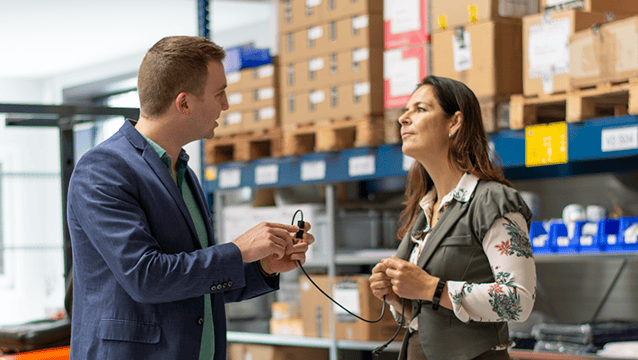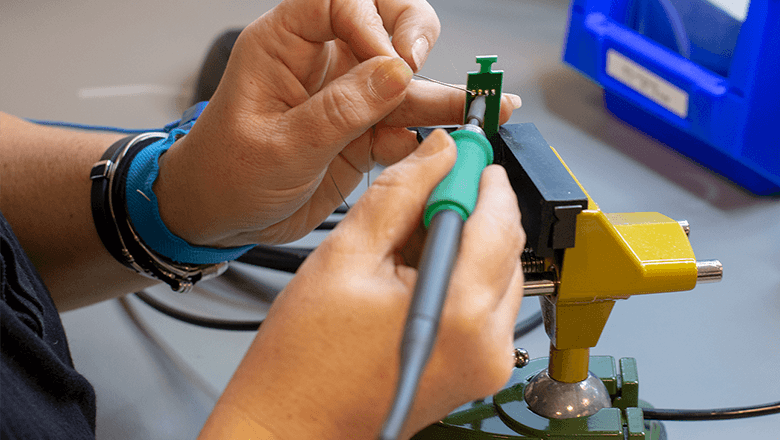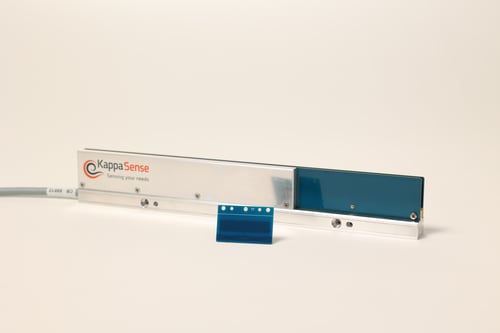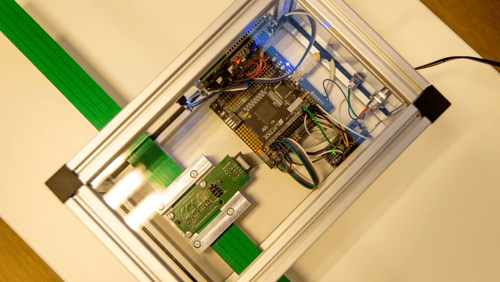Efficient engineering: avoid technical problems in your machine

When you engineer efficiently, you use components and technologies that perfectly balance your sensor solution — mechanically, electrically, as well as esthetically. But what’s even more important is to produce your solution in series with no technical problems. It’s about having a robust design. How does efficient engineering work in a sensor integration project?
The start of such a project is crucial for its future progress. This is the time to make the right decisions. Are you aware of how environmental factors influence the measurement results? Humidity and temperature fluctuations are just a couple of examples of this. And have you thought about the type of input and output signals you want and/or need?
Avoid surprises in a later phase of your sensor integration project. By answering the right questions, you will be well prepared. That’s how you easily integrate your reliable components into your machine. Here, Marie-José Wolters, Account Manager at Sentech, shares with you her experience with efficient engineering.
Make the right decisions through efficient engineering
“Making machines better by using the right sensor — that is the core of our activities,” states Wolters. When a question is posed to Sentech’s office in Nieuwkuijk (NL), the engineers first determine which sensor technology is most suited to solving the problem. “That is the basis, that’s where we start. Often a client already has a good idea of which direction to proceed in. But, because we have more specialized sensor knowledge in house, sometimes we need to make adjustments.”
The following steps are where the added value of a sensor integrator really becomes apparent. “Most sensors are delivered with just a wire, and that’s it,” says Wolters, knowingly. “But what do you do with the output signal? How do you robustly integrate such a sensor in the application? And how do you ensure that the selected sensor assembly is also produced according to the guidelines? It is precisely on these points that our expertise makes the difference. By making the right choices at the front end, you eliminate most of the customer’s concerns and you enjoy the most gains at the back end.”
Optimal design without concessions
The devil is in the details — and that is also true for the design and production of sensor assemblies. “As a company, if you have never gone through that process or don’t reflect on it properly, it is bound to go wrong,” says Wolters from experience. “Even the smallest element can throw a wrench in the works.”
That process, including proper reflection, starts with an apparently simple component such as the connector. “Typically, a contact has two functions: it provides a good electrical connection and a good mechanical connection. Here, you look for the optimum, without making concessions,” explains Wolters. “For example, you must make sure that the diameters of the wires match. Otherwise you will never be able to make a good crimp. Manufacturers also prescribe an optimal crimp height, a parameter around which you must arrange the production process and which you must continuously monitor. Larger parties often employ specialized engineers who can properly select a connector, but this knowledge is entirely lacking among smaller customers. In this situation, we are happy to help and advise them — and to thoroughly balance all the processes.”

Efficient engineering means working according to high quality standards, such as IATF 16949. Only then do you obtain a reliable and durable final product.
Guaranteed waterproof for agricultural applications
For a considerable number of agricultural customers, specific properties are key. “Being water-resistant and waterproof are important requirements in that market,” Wolters knows. “We then discuss which IP class is desired. The requirements for the housing and the connectors follow from there.”
Wolters recently worked for a customer on a sensor solution that used double crimps. These are points at which two wires meet. “Experience has shown that such a double crimp presents a significant risk of water creeping between the sensor wires due to capillary action. This can cause them to rust, so that requires measures to be taken,” according to Wolters.
In consultation with the customer and the Sentech engineers, a special housing with an overmold was selected. “With the use of a die, we made sure that everything was neatly aligned during production,” says Wolters. “First a die with a mold, then the PCB with all the electronics, and then an overmold. This was how we could guarantee that everything would be waterproof.”
What do you really need?
Everything depends on ‘the question behind the question’. “That may sound like a cliché but it really is true,” Wolters laughs. “Back to the start: ‘Why are you asking that? What do you really need?’ This is how you start at the beginning so you, as a specialized partner, don’t jump into the project halfway. And, once a selection has been made: ‘How are you going to integrate the sensor in the system? What else do you need to use the sensor signal wisely?’ In a machine, you can house the electronics in a PLC cabinet but with an agricultural vehicle, for example, that approach is less obvious. Together with the customer, we look for the best solution.”
This approach nearly always leads to custom work that regularly goes beyond the specifications provided by the sensor suppliers in their product descriptions. Wolters continues, “We then build a test set-up to challenge the sensor and thoroughly research whether it can indeed do what we expect of it.”
Quite a few expert skills are involved in that custom work. A great many of those skills are provided by Sentech’s in-house specialists. “For instance, I recently had an issue with an optical sensor,” relates Wolters. “Direct sunlight could disturb the measurement. Then I approached a colleague who had previously dealt with that issue and I explained the current problem. He came up with all kinds of solutions, from building blocks such as caps and filters to a signal frequency that is less susceptible to sunlight. One way or another, thinking further is ingrained in Sentech. That is the Sentech way of working.”
Efficient engineering with this proven method
By now it should be clear: Efficient engineering starts at the beginning of a project. This is the time when the right questions are asked so the reliability of your final product can be guaranteed.
Eventually, it’s about the balance between quality, costs and turnaround time. These never go hand in hand. How do you find the ultimate compromise here? Let yourself be inspired by our method — originating in the automotive branch — that helps you manage the risks.
Develop a reliable machine in 5 phases.




